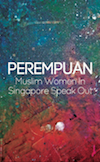-
Advocacy Theme
-
Tags
- Abortion
- Adoption
- Caregiving
- CEDAW
- Disability
- Domestic Violence
- Domestic Workers
- Harassment
- Healthcare
- Housing
- International/Regional Work
- Maintenance
- Media
- Migrant Spouses
- Migrant Workers
- Muslim Law
- National budget
- Parental Leave
- Parenthood
- Polygamy
- Population
- Race and religion
- Sexual Violence
- Sexuality Education
- Single Parents
- Social Support
- Sterilisation
- Women's Charter
Perempuan: A Review
December 14th, 2016 | Muslim Women's Rights, News, Views
To read more about the latest AWARE publication, Perempuan, an anthology by Muslim women in Singapore, click here.
A review by Kamalia
 My body belongs to me. My body is not public property. – Nur Diyana
My body belongs to me. My body is not public property. – Nur Diyana
This is my story to tell. – Orchid Blue
My body. My story. Me.
Above the noise of stereotypes and narratives imposed on Muslim women in Singapore, Perempuan raises its voice loud and clear. The voices are all of women; 31 anecdotes, personal stories and opinion pieces of women have come together to form this anthology about women’s experiences.
Perempuan is the first in the local literary scene to explore this particular intersection of Muslim, Malay and female identities. Furthermore, the majority of its contributions have been written in English and the rare few that are in Malay have been published alongside an English translation.
In Singapore, this means that Perempuan opens itself up to readers beyond the Malay community. These thoughts and experiences may be of the minority, but that neither detracts from its value nor makes it any less relatable to someone outside this collection of women voices.
Issues that were commonly discussed include body image (‘Can I Have My Body Back?’, ‘You Have to Lose Weight’), female sexuality (‘Orchid Blue’), female body autonomy (‘Armpits, Breasts and Vulva’, ‘My Body is Not Public Property’), female circumcision (‘Leave Them Alone’, ‘The Pain of Remembering’), flawed mother-daughter relationships (‘Ibu (Mother)’, and ‘Crossing the Ocean, Crossing the Boundaries’). While the narrative threads overlap each other in subject matter, each remains unique, nuanced, and wholly its own.
The variety in Perempuan is also evident in the styles of writing. Some employ more artistic flourish while others are simpler, more straightforward. Yet, this unevenness is essential in such an anthology. There is no need for homogeneity, for convention and stereotype in Perempuan. Still, what resounds is the varying degrees of subjugation and social pressures that a Singaporean Muslim woman might face.
As a Singaporean Muslim woman, I get to read about myself. In Perempuan, there are stories I identify with because they are my stories too. To find real representation in a book is to experience the precious sense of validation. Perempuan legitimatizes what has been silenced, lends a language to what I think and feel, and lets me know I am not alone.
But there are other anecdotes that I am surprised or even uncomfortable to read about. These are just as important as points of reflection for me on the judgment and assumptions that Muslim women not only experience, but worse still, inflict on each other in Singapore.
Ultimately, it is in the variety of voices where the strength of this anthology lies. The myriad of narratives that cross paths in the compact book only hints at the countless others that go unsaid, that remain self-censored.



